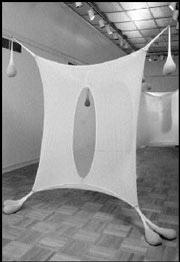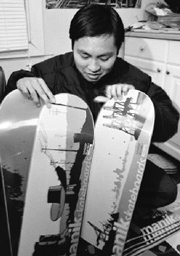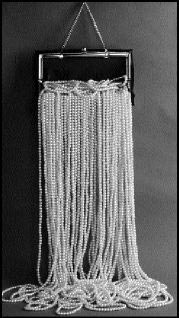FOR 105 YEARS, Italy’s Venice Biennale has topped Europe’s list of important art events. Every two years, the city of islands connected by boats and bridges gives its soul over to showcasing visual art. Work in every medium from all around the world is installed in national pavilions, local parks and gardens, office buildings, churches, warehouses—even a 12th-century shipyard. In size, the latter venue, known as the Arsenale, covers one-fifth of the city’s total geography. It offers the artists who are invited to show there use of incredible spaces and the possibility of worldwide acclaim.
One of this year’s most popular pieces in the Arsenale has a special resonance for our own waterside city. It is a huge, hanging web of semitransparent nylon, sculpted into curves and holes through which emerge fabric pendulums filled with cloves and colored with spices. The powerful, seductive work, O Bicho, comes from young Brazilian artist Ernesto Neto, and it will be displayed through Nov. 4. But until Jan. 2, 2002, an equally complex, delicate piece by the same artist is on view here in Seattle. This is Neto’s large, tentlike tulle sculpture “Flying Gloup Nave.” The installation, which invites viewers to walk inside and touch its inner walls, provides one “chapter” of the Henry Gallery’s show “Short Stories.”
“Nave” means “ship,” or “vessel,” and Neto’s works often voyage between the organic and the abstract; viewers around the world have become participants in his vision. This fabrication at the Henry is owned by local collectors, a fact that typifies some recent changes in our city’s visual arts culture: 1) Seattle has now evolved a highly diverse art scene, where an increasing number of artists work in an international context; 2) more of the locals who are now buying art choose adventurous, difficult works, not merely decorative art or investments; and 3) more collectors now see local artists as able to hold their own in global terms.
Rebecca and Alexander Stewart own the Flying Gloup Nave and two other Neto pieces. They have been collecting art since the early ’90s and possess work by some other provocative art-world names: theatrical British installationist Cornelia Parker; Canadian video artist Stan Douglas; and even Texas-based Dario Robleto, who creates from melted Billie Holiday records and “stolen lipsticks.”
“When I was starting out [as a collector],” Rebecca Stewart recalls, “I was less aware of people working here in my own city. There was just so much glass, you know, and a stable of midcareer artists. Everything seemed pretty complacent. What I wasn’t seeing was younger artists aware of other artists’ work in the rest of the world.”
Now, she says, “There’s a lot of really good work being made here. When we’re at home, we feel like we just don’t get out to see enough.”
The audience for the Stewart collection—11 pieces of which are currently on loan outside of Seattle—is not an aberration. For instance, on May 30 London’s Tate Gallery announced the shortlist for its prestigious Turner Prize (to be awarded Dec. 9). One of the four finalists is British filmmaker Isaac Julien, nominated for his multiscreen art installations. The longest of these, The Long Road to Mazatlᮼ/I>, is owned by Seattle collectors Bill and Ruth True.
The Trues collect a lot of digital moving-image art; they own works by artists such as Gary Hill and Paul Pfeiffer (both of whom presented at this year’s Biennale). Says Bill True, “I’m really into multiprojection pieces. In fact, I’d like to see them projected on the screens at Husky Stadium or Safeco Field.”
Failing that, the Trues are searching for a space to use as a showcase. “But we have five kids between the ages of three and 17. Everything we do is dictated by school schedules, so in town we mostly kind of hang out at the Henry.”
LIKE MOST local collectors, however, they are acquainted with galleries such as Howard House, James Harris, and Esther Claypool. Over the past three years, these three venues have played especially supportive roles for Seattle art. Each has helped bridge the gaps between Sea-Tac and destinations elsewhere, to the benefit of emerging local artists. Each has also succeeded in enticing new buyers—increasingly, younger patrons with fewer fears about seeming “provincial.”
James Harris cites two changes that have been pivotal to this trend: “More Seattleites now travel to events—the Venice Biennale, ArtBasel, or Site Santa Fe—where they can see the bigger international picture. I also see collectors who started with local artists very excited about expanding the scope of their interest.”
This doesn’t mean, he says, that local art will be ignored. “It just shows that good artists here are part of a larger discourse.”
Since opening his gallery in June 1999, Harris himself has shown impressive art from both North American coasts, as well as Brazil, Germany, and Great Britain. However, just like Howard House and Esther Claypool (the latter is committed only to locally based artists), Harris heavily backs Seattle artists, showing Patrick Holderfield, Nicola Vruwink, Claire Cowie, Yuki Nakamara, and Sean Vale.
The persuasive connections of many other names have also empowered our visual arts scene, including the respected curator Lisa Corrin (now Seattle Art Museum’s new deputy director for art), as well as a group of dealers and galleries from Tanya Bonakdar in New York to Rio’s Camargo Vila确 The outreach of certain organizations also played a part, especially San Antonio’s flourishing ArtPace. There, in addition to bold exhibitions and guest-star rosters, curators cater very carefully to collectors—including ours.
Developer Carol Bennett is a collector who buys only local artists. But, she says, Seattle could use the ArtPace scale of funding and confidence. “A lot of what collectors like the Trues are doing now is as much about the intellectual interest as the value. But who is coming forward to expand that conversation? From everyone at the city, it’s still, ‘But what’s the mainstream version?’ That kind of attitude infuriates good artists. We have the vision in our art, but it needs equally smart support.” She pauses. “To ignore that fact is absolutely provincial.”







